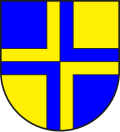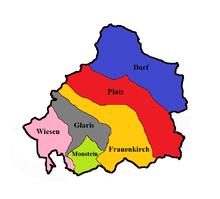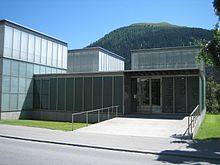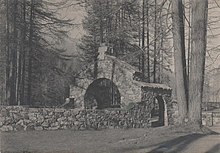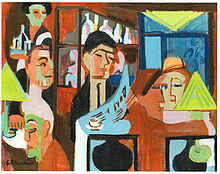Davos
| Davos | |
|---|---|
| State : |
|
| Canton : |
|
| Region : | Prättigau / Davos |
| BFS no. : | 3851 |
| Postal code : | 7260 Davos Dorf 7270 Davos Platz |
| UN / LOCODE : | CH DPZ (Davos Platz) |
| Coordinates : | 781 892 / 185 191 |
| Height : | 1560 m above sea level M. |
| Height range : | 1051–3145 m above sea level M. |
| Area : | 284.00 km² |
| Residents: | 10,899 (December 31, 2018) |
| Population density : | 38 inhabitants per km² |
| Website: | www.gemeindedavos.ch |
|
Davos, looking south |
|
| Location of the municipality | |
The municipality (traditionally: landscape) Davos ( [daˈfoːs] or [daˈvoːs] , in the Walser German local dialect Tafaas [ taˈfaːs ], also Tafaa [ taˈfaː ], Rhaeto-Romanic , Italian Tavate ) comprises almost the entire Landwasser valley in the Swiss canton of Graubünden . The municipality with numerous settlements existed until the end of 2018 from the six fraction municipalities Davos Dorf, Davos Platz, Davos Frauenkirch , Davos Glaris , Davos Monstein and Wiesen of Prättigau / Davos region , of which since then nor that alone exists of Monstein. Since the middle of the 19th century Davos has developed into a well-known climatic health resort and winter sports area; the population rose from 1,680 in 1850 to over 11,000 in 1930.
coat of arms
Blazon : embedding blue and gold, topped with embroidered cross in mixed up colors.
Traditional coat of arms of the Ten Court Association . The original coat of arms of the Ten Courts Association was probably a yellow cross on a blue background. This color distribution and the cross shape were clearly visible and easy to describe.
geography

Davos landscape
The territory of the Davos landscape encompasses the largest part of the Landwasser Valley and extends at Davos Wolfgang ( 1631 m ) a good two kilometers over the watershed into the Prättigau . The axis of the valley, marked by the river, main road and railway line, runs from northeast to southwest. From Lake Davos , it drops very gently at first, just under 60 meters over eight kilometers. In this section, the two side valleys Flüela and Dischma flow from the left , which provide access to the Flüelapass and Scalettapass crossings leading into the Engadin . From the confluence of the third, like the aforementioned 10 km long side valley, the Sertig valley, the valley floor becomes narrower and falls by almost 300 meters over the remaining nine kilometers to the former municipal boundary at the Felsenge Brombänz. The deeply cut lower section of the valley is called the Zügen Gorge . Beyond the Zügen Gorge is the Wiesen fraction, which has also been part of Davos since January 1, 2009.

The right (northwest) flank has only a few short side valleys. Here the municipal boundary - at the same time the watershed against the Plessur area - runs over the summits of Amselflue ( 2771 m ), Tiejer Flue ( 2781 m ), Mederger Flue ( 2674 m ) and Chüpfenflue ( 2658 m ) to the historically significant Strela pass . Beyond the saddle, it continues over the Schiahorn ( 2709 m ) to the Weissflue ( 2834 m ). In the north, the municipal boundary runs on the Casanna and the Gotschnagrat . The left side of the valley is divided into protruding ridges by the three side valleys. Seen from the valley, the upstream mountains Seehorn ( 2238 m ), Büelenhorn ( 2512 m ), Jakobshorn ( 2590 m ) and Rinerhorn ( 2528 m ) dominate the picture. The greatest heights, however, are found along the watershed towards the Engadine and the upper Albula valley : Flüela Wisshorn ( 3,085 m ), Flüela Schwarzhorn ( 3,147 m , highest point in the municipality), Piz Grialetsch ( 3,131 m ), Chüealphorn ( 3,078 m ) and Hoch Ducan ( 3063 m ).
Districts of Davos
The six districts - until the end of 2018 autonomous parliamentary groups - are in the direction of the river Landwasser :
- Davos Dorf, including the Flüela valley, the Wolfgang settlement with the road crossing at the top of the Wolfgang pass and the hamlet of Laret on the other side of the pass,
- Davos Platz, including the Dischmatal,
- Davos Frauenkirch , including the Sertig Valley,
- Davos Glaris
- Davos Monstein (since 2019 the municipality's only public authority)
- Davos meadows
The Fractions Frauenkirch, Glaris and Monstein together form the undercut, the Fractions Platz and Dorf the overcut .
The two largest fractions of the village and square are located in the almost flat upper section of the valley and have merged into a four-kilometer-long ribbon of settlements as a result of construction activity in the 20th century. A large number of individual farms and Alpine settlements are scattered across the entire municipality .
At 254.54 km², Davos was the second largest municipality in Switzerland in terms of area until the beginning of 2009. In 1997, 37.1% of the area was used for agriculture as meadows and pastures, the forest took up 19.7% and the settlements 2.2%. 41.0% were considered unproductive.
With the incorporation of Wiesen at the beginning of 2009, Davos became the largest municipality in Switzerland just before Bagnes (282 km²), but lost this leadership position again at the beginning of 2011 to the newly created municipality of Glarus Süd .
Neighboring communities are Arosa , Bergün Filisur , Klosters-Serneus , S-chanf , Schmitten and Susch .
climate
The annual mean temperature is 3.5 ° C, with the coldest monthly temperatures in January at -4.9 ° C and the warmest monthly mean temperatures in July at 12.4 ° C. On average, around 193 frost days and 58 ice days are to be expected here. There are summer days on an annual average of 3.5, no hot days were recorded in the normal period 1981–2010. The MeteoSwiss weather station is located at an altitude of 1594 m above sea level. M.
| Davos, 1981-2010 | ||||||||||||||||||||||||||||||||||||||||||||||||
|---|---|---|---|---|---|---|---|---|---|---|---|---|---|---|---|---|---|---|---|---|---|---|---|---|---|---|---|---|---|---|---|---|---|---|---|---|---|---|---|---|---|---|---|---|---|---|---|---|
| Climate diagram | ||||||||||||||||||||||||||||||||||||||||||||||||
| ||||||||||||||||||||||||||||||||||||||||||||||||
|
Average monthly temperatures and precipitation for Davos, 1981–2010
Source:
|
||||||||||||||||||||||||||||||||||||||||||||||||||||||||||||||||||||||||||||||||||||||||||||||||||||||||||||||||||||||||||||||||||||||||||||||||||||||||||||||||||||||||||||||||||||
The heat record in Davos was set on June 27, 2019 at 29.8 ° C.
history
Davos as a farming village
Although individual finds in several places in the Davos landscape suggest that people have been moving through the area since the Bronze Age, the valley has probably only been populated since the High Middle Ages . First, Romansh migrated from the Albula valley and the Engadine . Individual place and field names still indicate this Romanesque layer today ; the name Davos itself, documented as Tavaus in 1213 , is derived from late Lat. * tovu ‚Tobel '< tubus ‚ Röhre ' traced back: * ad tovātos ‚with places covered by ravine rubble 'or * ad tovānes ‚ with the Tobelle people'
Around 1280, the barons of Vaz Walser settled colonists and granted them extensive rights of self-administration in the fiefdom of 1289. Davos developed into the largest Walser settlement in Graubünden, founded the Ten Court League in 1436 , as the main town of which the municipality exerted significant influence on the politics of the three leagues . In 1526 the site joined the Reformation . Until the current political communities were created with the new cantonal constitution in 1851, Arosa also belonged to Davos as a neighborhood .
Up until the second half of the 19th century, cattle breeding was the main occupation. On the left slope of the Zügen Gorge - called Silberberg - lead and zinc ores were mined from the 15th to 19th centuries.

Davos as a health resort
In 1853 Alexander Spengler and later Willem Jan Holsboer discovered the beneficial and health-promoting climate of the low-pathogen mountain air, which is particularly beneficial for people with lung disease (e.g. tuberculosis and asthma ). The fact that no house dust mites live at this altitude has a supportive effect . In 1855 Hermann Brehmer initiated the era of the lung sanatoriums in Görbersdorf in Silesia , the contemporary model for all climatic health resorts (later called "Silesian Davos") .
One of the first winter spa guests in 1865 was Hugo Richter (1841–1921) from Königsberg, who was suffering from tuberculosis. The news of its rapid healing and other such healing stories made Davos world famous as a climatic health resort. Richter stayed in Davos. In 1881 he founded the Davoser Zeitung . The liberal newspaper strongly advocated the tourist development of the region. The Davoser Blätter , an entertaining magazine for the spa guests , also appeared in his publishing house . The Davoser Blätter regularly published guest lists that received a lot of attention and were a topic of conversation.
With the construction of the railway line from Landquart to Davos and its opening in 1890, the development of the place was accelerated: Hotels , guest houses, sanatoriums and villas were built in large numbers. This made Davos world famous as a climatic health resort . Davos was decisively shaped by the master builder and governor Gaudenz Issler (1853–1942).
As a result, many cantons and states began to build their own sanatoriums in Davos. The best known, which still exist today, are the Deutsche Hochgebirgsklinik Davos Wolfgang, together with the Clinic Nederlands Astmacentrum Davos and the Zürcher Höhenklinik Davos Clavadel. Others were canceled, such as the Alexanderhausklinik in 2004 , the Thurgauer / Schaffhauser Höhenklinik Davos in spring 2005 and the Basel sanatorium .
Thomas Mann's novel Der Zauberberg (1924) is set in Davos. It is based on his wife's stay in a Davos lung clinic before the First World War . In tourist advertising, the magic mountain is identified with the Hotel Schatzalp .
Davos as a winter sports resort
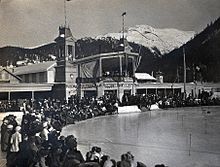
The first toboggan race was held in Davos in 1883. In addition to toboggan races on a separate track, bobsleigh races were also held from Schatzalp . The writer Arthur Conan Doyle described skiing in Davos in a humorous essay in 1889 and thus sparked the popularity of the place, especially among the British, which continues to this day. The Davos sledge was also created at this time . In 1906, the first women's ice skating world championships took place in Davos . In December 1934 in Davos am Bolgen, the world's first ski-lift was put into operation by the Davos ski school . The almost 300 meter long lift was documented in a short film in January 1935. Today La Nuit blanche takes place there every year .
A peculiarity of Davos were the cable car companies that operated separately until a few years ago and opened up several separate ski areas in the Davos / Klosters area: Schatzalp / Strela , Brämabüel / Jakobshorn , Parsenn , Pischa , Rinerhorn and Madrisa (near Klosters). In 2002 the lift operation on the Schatzalp was stopped. In the 2009/10 winter season, the Schatzalp / Strela ski area was reopened to a reduced extent.
The largest natural ice rink in Europe is still located in the center of Davos . This was the first time since 1914 that a bandy tournament was held in Switzerland on January 6, 2014 . The 2016 European Bandy Championship for men is the 2nd edition of this tournament and will also take place here. Right next door is the Vaillant-Arena ice rink , home of HC Davos , which was founded in 1921 . As a “record champion”, he has won 31 Swiss championship titles so far . The stadium has a capacity of 7,080. The Davosers achieved their last success in 2015 when they defeated the ZSC Lions 4-1 in the final series .
Since 1923, HC Davos has welcomed five - up to and including 2009 four - club teams to the international ice hockey tournament for the Spengler Cup every year between Christmas and New Year . The hosts are the record winners with 15 victories, the last success being a 3-2 win over Dinamo Riga in the 2011 final.
The Davos Nordic has been held annually since 1972 . These races have officially been part of the FIS Cross-Country World Cup series since 1980. Athletes like Thomas Wassberg and Bjørn Dæhlie celebrated victories in Davos. Davos Nordic can also benefit from the great successes of Dario Cologna - the event has seen a considerable surge in development since 2007 and the number of spectators has multiplied.
In summer, water sports such as windsurfing and beach volleyball can be practiced in the outdoor pool on Lake Davos .

Davos in winter from the air - looking north, Parsenn in the background
International headlines
Davos hit the international headlines in 1936 when the Jewish student David Frankfurter shot and killed Wilhelm Gustloff , the NSDAP regional group leader for Switzerland, who had moved from Germany to Davos in 1917 . The National Socialists responded to Switzerland with verbal attacks, while Frankfurter was sentenced to life imprisonment in Chur that same year (pardoned and expelled in 1945).
population
Davos has 12,751 inhabitants and a proportion of foreigners of 31.9% (as of January 1, 2017). The population is distributed among the different parts of the village as follows:
| fraction | Residents | Area in km 2 |
|---|---|---|
| Village | 3,642 | 63.89 |
| space | 7,334 | 77.26 |
| Frauenkirch | 421 | 57.52 |
| Glaris | 404 | 30.21 |
| Monstein | 189 | 25.53 |
| grasslands | 389 | 29.58 |
| Davos landscape | 12,751 | 283.99 |
Since Davos was settled by German-speaking Walsers, the only official language is German.
religion
At over 70%, the majority of Davos residents belong to a regional church : 36.2% are Protestant Reformed and 35.1% are Roman Catholic (as of 2017).
Since the census in 2000, the religious composition of the inhabitants who do not belong to any regional church has not been recorded. At that time, 5.1% belonged to another Christian church (3.8% Christian Orthodox , 1.3% other Christian communities), 0.7% were of the Muslim faith , 0.1% of the Jewish religion and 0.5% were members another religious community. The proportion of unchurched was 7.3%, also made 3.9% of the population not their religion.
Population development

politics
legislative branch
The legislature in the Davos region is the Grand District Administrator . It consists of 17 members and is re-elected every four years by the people in a majority procedure. The president changes annually.
The parties have the following seats in the current legislature (2017–2020): FDP 7 seats; SVP 3 seats; SP 2 seats; GLP 2 seats; CVP, BDP and EVP each have one seat.
executive
The executive in the Davos region is the small district administrator . It consists of five members and is elected by the people every four years. Its seat is the town hall built in 1564.
Members for the 2017-2020 term of office are:
- Tarzisius Caviezel ( Landammann ), FDP
- Valérie Favre Accola (Department of Education and Energy), SVP
- Christian Stricker (Department of Health and Safety), non-party
- Simi Valär (Department of Building Construction and Environmental Protection), FDP
- Stefan Walser (governor, Department of Civil Engineering and Public Enterprises), SP
National elections
In the 2019 National Council elections, the proportion of voters in Davos was: SVP 31.8%, SP 22.1%, FDP 16.4%, glp 9.5%, BDP 8.1%, CVP 7.8%, Greens 4.5 %.
Town twinning
-
 Aspen in the state of Colorado , United States
Aspen in the state of Colorado , United States -
 Chamonix in the Auvergne-Rhône-Alpes region , France
Chamonix in the Auvergne-Rhône-Alpes region , France -
 Ueda in Nagano Prefecture , Japan (originally today's suburb of Sanada)
Ueda in Nagano Prefecture , Japan (originally today's suburb of Sanada)
In February 2010 the municipality decided on a drastic austerity program (“Program for the sustainable improvement of municipal finances”). With this program, the town twinning was also canceled because it did not bring any financial income.
Infrastructure
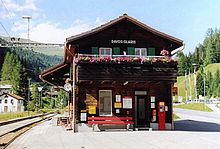
traffic
Streets
Davos can be reached from the north via the Prättigau and Hauptstrasse 28 . Since this road is the main feeder to Davos, the Prättigau suffers a lot from traffic. Therefore, the street in the Prättigau became federal property ( N28 ). In addition, many bypasses were built for the traffic-plagued villages. Other roads lead east over the Flüelapass into the Engadin (H28) and south-west to Tiefencastel and Thusis (H417) or via Lenzerheide ( H3 ) to Chur .
In Davos itself, two one-way streets serve as the main street; the slightly higher promenade to the southwest and the valley road in the valley to the northeast. Both streets are connected by many side streets. From north to south these are: Dischmastrasse , Schiaweg , Reginaweg , Hertistrasse , Kurgartenstrasse , Tobelmühlestrasse , Guggerbachstrasse , Hintere Gasse .
train
Davos can be reached by train with the Rhaetian Railway (RhB). On the one hand via the Landquart – Klosters – Davos Platz railway line from Landquart and on the other via the Filisur – Davos Platz line from Filisur. These connections run every hour. The community has eight stations. The two most important are the Davos Dorf and Davos Platz train stations .
bus
The local bus network operated by the Davos Landscape Transport Authority (VBD) together with PostAuto Schweiz AG and the two local transport companies Stiffler and Kessler connects Davos Dorf and Platz with the outskirts and the side valleys on eight lines. The PostBus route 183 connects Davos with Chur via Alvaneu and Lenzerheide. Another line, the 331, runs over the Flüela Pass to Susch in the Lower Engadine, from where there is a connection to the Rhaetian Railway.
Mountain railways
Three mountain railways lead from Davos itself and two from the suburbs to the surrounding mountains.
Teaching and Research
Davos is home to a number of z. Some internationally known research institutions :
- the WSL Institute for Snow and Avalanche Research SLF is part of the WSL and thus part of the ETH Domain
- the world radiation center (PMOD / WRC)
- the AO Research Institute for the study of bone healing .
- the Swiss Institute for Allergy and Asthma Research (SIAF)
- the Global Risk Forum (GRF)
Furthermore, Davos is home to two middle schools and grammar schools with an attached boarding school:
- Swiss Alpine Middle School Davos (SAMD) with approx. 270 students
- Swiss Sport Gymnasium Davos (SSGD) with approx. 120 students
Davos is also home to the Davos cantonal vocational school , whose catchment area is the Davos-Prättigau-Albulatal region.
Events
Davos is an internationally known congress location. Recurring congresses from all areas of medicine take place there every year. The World Economic Forum (WEF), which is held annually in January and founded by Klaus Schwab , ensures global headlines and demonstrations .
The Swiss Alpine Marathon is the highest ultramarathon in Europe. In addition, Davos has been the destination of the Swiss Irontrail mountain run since 2013 .
Davos is also the starting point for the Davos Classic vintage car rally . Classic automobiles that were manufactured up to 1984 will be used on the surrounding Alpine pass routes.
The Spengler Cup , which takes place every year between Christmas and New Year, is the world's most famous ice hockey club tournament. A total of 80,000 spectators attend the event.
Sir Arthur Conan Doyle crossed the Maienfelder Furgga to Arosa on skis from Davos in the winter of 1894 together with the local brothers Johann and Tobias Branger . He then described the undertaking in detail in the English magazine Strand Magazine . This article contributed significantly to the fact that Davos and Graubünden became very popular, especially with the English . It can be seen as legacy of this article that every year the British-Swiss Parliamentarian Ski Race takes place, in which only Swiss and British MPs take part.
Culture
Thomas Mann made Davos famous in the German-speaking world with his novel Der Zauberberg , which appeared in 1924 and was later filmed . The sanatorium described in the book was the forest sanatorium , which is now run as the Waldhotel Davos (formerly Waldhotel Bellevue ).
The famous German expressionist and co-founder of the artists' association " Brücke " Ernst Ludwig Kirchner spent the years 1917 to 1938 in Davos. He lived first on the Stafelalp, later in the “Haus in den Lärchen” in Davos Frauenkirch and finally in the house on the Wildboden until his suicide.
Davos as a health resort also appears in the novel Stiller by Max Frisch in which Julika, the wife of the main character, a time when tuberculosis patient spent here.
Attractions
The Kirchner Museum Davos, which opened in 1992 on Ernst Ludwig Kirchner Platz , presents an extensive collection of works by the German expressionist Ernst Ludwig Kirchner .
The Parsennbahn on the Weissfluhjoch was the second downright sports track (track that is only aimed at athletes as passengers) in Switzerland.
The architecture in Davos is characterized by a flat roof style which is unusual for the region and which has found its way into architectural history as the Davos flat roof .
The city promenade is a popular shopping street and there is a one-way system in the town center, with the exception of public transport buses.
The following buildings and facilities are noteworthy:
- Reformed Church of St. Johann
- Reformed Church of St. Theodul
- Catholic Church Heart of Jesus
- Catholic Marienkirche
- Former Anglican Church of St. Luke's (Free Evangelical Congregation)
- Doctor's house of the Thurgauisch-Schaffhausische Heilstätte
- RhB reception building
- Blue houses
- "Boy's Fountain"
- Former doctor's house of the Basler Höhenklinik
- Former “Grand Hotel Belvédère” (today “Steigenberger Grandhotel Belvédère Davos”)
- Former Schatzalp sanatorium
- Former school building Davos Dorf (physical-meteorological observatory / world radiation center)
- "Big Jenatschhaus"
- Congress center and indoor swimming pool
- Kurpark: gate building 1916, bronze sculpture breathing , fountain system
- "Upper Jenatsch House"
- town hall
- school
- Ski falls fountain
- Sports center, 1996, by architects Mike Guyer and Annette Gigon
- "Lower Jenatschhaus"
- Convertible path
- “Youthpalace”, 2002, by architects Gian Carlo Bosch , Martin Heim and Reto Zindel
- Two- family house on Tanzbühlstrasse
- Waldfriedhof Davos : In 1920 Rudolf Gaberel designed the Waldfriedhof in collaboration with Christian Issler and the architect and sculptor Erwin Friedrich Baumann . Baumann was responsible for the artistic design. The facility is located in an existing larch grove; the enclosure was made of dry masonry, with a cyclopean entrance gate. The row graves are arranged in an elliptical overall shape, the private graves are scattered over bumps in the natural topography. According to the cemetery regulations, only simple wooden crosses made of larch and uncut looking local stones are allowed to decorate the graves. In the area of the private graves there are grave sites of Ernst Ludwig Kirchner and his life partner Erna Schilling as well as Rudolf and Rosa Gaberel; various gravestones are from Wilhelm Schwerzmann . After the Swiss Association of Israelites had campaigned for this from the 1910s, a Jewish cemetery was added to the complex in 1930 . This was first used for a Jewish burial in October 1931; a young man named Leos Krupkin.
- Wiesen Viaduct of the Rhaetian Railway, in the area of the former Wiesen parliamentary group
Personalities
-
Science:
- Lucius Burckhardt (sociologist and economist)
- Carl Dorno (naturalist and founder of PMOD)
- Peter Heintz (sociologist, founder of the Sociological Institute of the University of Zurich)
- Marianne Leuzinger-Bohleber (psychoanalyst)
- Walter Siegenthaler (doctor)
- Alexander Spengler (doctor)
- Carl Spengler (doctor and ice hockey player and founder of the Spenglercup )
- Lucius Spengler (doctor)
-
Art / culture / media:
- Martin Accola (clergyman)
- Philipp Bauknecht (artist)
- Pascal Bergamin (filmmaker)
- Valentin Bühler (lawyer; author of the first dictionary on the dialect of Davos)
- Beatrice Obrecht Delgado (singer)
- Hans Domenig (pastor)
- Juri Elperin (Russian-German translator)
- Andreas Fabricius , (reformer)
- Jürg Federspiel (writer)
- Helene Fischer , photographer
- Marc Forster (director, honorary citizen since November 2007)
- Ernst Haefliger (tenor)
- Conrad Jon Godly (Artist)
- Urs Gredig (journalist and television presenter)
- Thomas Hirschhorn (artist)
- Arthur Honegger (journalist, moderator and author)
- Franz Holper (artist)
- Klabund (writer)
- Ernst Ludwig Kirchner (artist)
- Eberhard W. Kornfeld (art collector, art dealer and honorary citizen of the Davos landscape)
- Emil Meerkämper (photographer)
- Robert Louis Stevenson (writer)
- Erwin Poeschel (art historian)
- Peter Studer (lawyer and publicist)
- Sophie Taeuber-Arp (artist)
- Hans Valär (architect and spa director; writer of dialect literature)
-
Sports:
- Martina Accola (ski racer)
- Paul Accola (ski racer)
- Andres Ambühl (ice hockey player)
- Hans Dürst and Walter "Watschga" Dürst (ice hockey players)
- Konstantin Harter (ice hockey player)
- Beni Hofer (ski racer)
- Ambrosi Hoffmann (ski racer)
- Markus «Mä» Keller , snowboarder
- Daniela Meuli (snowboarder)
- Jan Neuenschwander (ice hockey player)
- Bibi Torriani and the brothers Hans Cattini and "Pic" Cattini known as ni-Sturm (ice hockey players)
- Thomas Wellinger (ice hockey player)
-
Politics and Entrepreneurship:
- Johannes Guler von Wyneck (chronicler, officer and governor)
- Willem Jan Holsboer (1834–1898) (hotelier, builder of the RhB and councilor)
- Johann Luzius Isler (Bündner confectioner and entrepreneur)
- Gaudenz Issler (builder and land manager)
- Andreas Laely (politician, editor and local historian)
- Klaus Schwab (founder of the World Economic Forum, honorary citizen)
- Fortunat spokesperson (lawyer, diplomat and chronicler)
literature
- Martin Bundi: Davos. In: Historical Lexicon of Switzerland .
- Fritz Dürst, Hugo Welti, Rudolf Indlekofer : Davos and its valleys. Basel 1964.
- Kasimir Edschmid , Walter Kern: Davos, the sunny city in the high mountains. (= Schaubücher. 38). Zurich / Leipzig 1932.
- Leni Henderson-Affolter: The Art Nouveau in Davos. Davos 1983.
- Leni Henderson-Affolter (editor): Landscape Davos. Yearbook 1992. Chur 1992, ISBN 3-907036-35-2 .
- Leni Henderson-Affolter: Once upon a time ... Lh Davos wrote. Schiers 1996.
- Marietta Kobald-Walli (project leader): Läsiblüescht. Prättigau and Davos dialect texts from 159 years. Edited by the Walser Vereinigung Graubünden. o. O. 2017, ISBN 978-3-909210-05-3 .
- Fritz Maron: Arosa - Relations between Arosa and Davos. Arosa 1951.
- Max Pfister: Davos landscape, independent, cosmopolitan highlands. (= Swiss homeland books. 182). Bern 1978, ISBN 3-258-02743-9 .
- Erwin Poeschel : The art monuments of the canton Graubünden II. The valleys of Herrschaft, Prättigau, Davos, Schanfigg, Churwalden, Albula valley (= art monuments of Switzerland. Volume 9). Edited by the Society for Swiss Art History GSK. Bern 1937. DNB 811066703
- Martin Schmid, Gaudenz Issler: Davos German Dictionary. The vocabulary of a Graubünden Walser settlement. (= Grammars and dictionaries of Swiss German. VII). Verlag Walservereinigung Graubünden, Chur 1982, ISBN 3-909210-00-7 .
Web links
- Literature from and about Davos in the bibliographic database WorldCat
- Official website of the Davos community
Individual evidence
- ↑ Permanent and non-permanent resident population by year, canton, district, municipality, population type and gender (permanent resident population). In: bfs. admin.ch . Federal Statistical Office (FSO), August 31, 2019, accessed on December 22, 2019 .
- ^ The pronunciation of standard German in Switzerland. A guide. On behalf of the Swiss Siebs Commission ed. by Bruno Boesch . Schweizer Spiegel Verlag, Zurich 1957, p. 36; Hans Bickel , Christoph Landolt : Swiss High German. Dictionary of the standard language in German-speaking Switzerland. Edited by the Swiss Association for the German Language . 2., completely revised and exp. Edition Duden, Berlin 2018, p. 102.
- ↑ Eva-Maria Krech among others: German pronunciation dictionary. Berlin 2009, p. 432.
- ^ Linguistic Atlas of German-speaking Switzerland , Volume V, Map 1.
- ↑ a b Lexicon of Swiss municipality names . Edited by the Center de Dialectologie at the University of Neuchâtel under the direction of Andres Kristol. Verlag Huber, Frauenfeld / Stuttgart / Vienna 2005, ISBN 3-7193-1308-5 and Éditions Payot, Lausanne 2005, ISBN 2-601-03336-3 , p. 289.
- ^ According to Arnold Büchli: Mythological regional studies of Graubünden. A mountain people tells. Part 1: Five villages, Herrschaft, Prätigau, Plessurtal, Chur, Davos. Sauerländer, Aarau 1958 (2nd, extended edition. Disentis 1989), p. 276; according to the unprinted material of the language atlas of German-speaking Switzerland (archive of the Swiss Idiotikons ) only in the neighboring Walser villages.
- ^ Davos in Glossario Helvetiae Historico .
- ^ Constitution of the community of Davos of November 24, 2019, Article 1, Paragraph 2.
- ↑ Climate table. (PDF) In: meteoschweiz.admin.ch. meteoschweiz, accessed on April 9, 2018 .
- ↑ Maximum temperatures - New heat records in both the north and the south. In: srf.ch . June 27, 2019, accessed June 27, 2019 .
- ↑ Bandy back in Davos. (No longer available online.) Davos.ch, January 1, 2014, archived from the original on December 17, 2013 ; accessed on May 10, 2015 .
- ↑ О Хабаровске, Олимпиаде и США (Russian)
- ↑ a b Davos community: A portrait of Davos. (PDF) Retrieved January 20, 2020 .
- ^ Davos: Resident population by religion. ( XLSX ) FSO, January 9, 2019, accessed January 20, 2020 .
- ^ Historical Atlas of the Federal Censuses. FSO, 2019, accessed January 20, 2020 .
- ↑ Data according to Martin Bundi: Davos. In: Historical Lexicon of Switzerland .
- ^ Municipality of Davos: Great District Administrator. In: gemeindedavos.ch. Retrieved March 13, 2014 .
- ^ Federal Statistical Office : NR - Results parties (municipalities) (INT1). In: Federal Elections 2019 | opendata.swiss. August 8, 2019, accessed August 1, 2020 .
- ↑ Eberhard W. Kornfeld: Well in the larches, Frauenkirch-Davos. E. L. Kirchner House 1918–1923. The story of a house in Frauenkirch . Kornfeld, Bern 2004, ISBN 3-85773-045-5 .
- ^ Christof Kübler: Rudolf Gaberel : Architecture as a cure. In: Franco Item : Davos - between mountain magic and magic mountain. Verlag Neue Zürcher Zeitung, ISBN 978-3-03810-036-2 , p. 217.
- ^ Catholic Church Herz Jesu
- ↑ Catholic Marienkirche
- ↑ Former Anglican Church of St. Luke's (Free Evangelical Congregation)
- ↑ Doctor's house of the Thurgauisch-Schaffhausische Heilstätte
- ↑ Reception building of the RhB
- ↑ Blue houses
- ↑ Boy's fountain
- ↑ Former doctor's house of the Basler Höhenklinik
- ↑ Former Grand Hotel Belvédère (today Steigenberger Grandhotel Belvédère Davos)
- ^ Former Schatzalp sanatorium
- ↑ Former school building in Davos Dorf (physical and meteorological observatory / world radiation center)
- ↑ Big Jenatschhaus
- ↑ Congress center and indoor swimming pool
- ^ Kurpark: Torbau 1916, bronze sculpture "Breathing", fountain
- ↑ Upper Jenatsch House
- ↑ City Hall
- ^ Schoolhouse
- ↑ Ski falls fountain
- ↑ Sports center
- ↑ Lower Jenatschhaus
- ↑ Wandelbahn
- ↑ Youthpalace
- ↑ Two family house
- ↑ Urs Hafner: Waiting in peace - a visit to the Jewish cemetery in Davos and a look back at its history . In: Neue Zürcher Zeitung . No. 163 . Zurich July 16, 2012, p. 31 .
